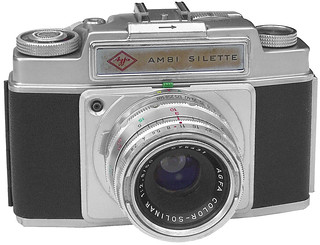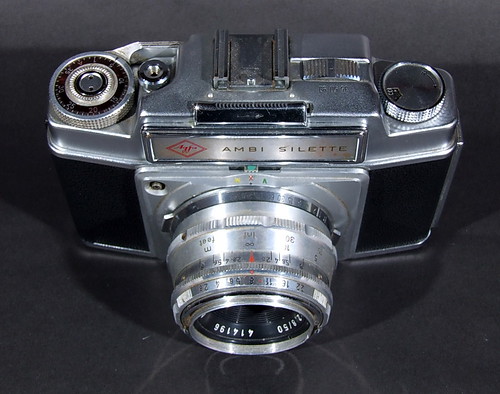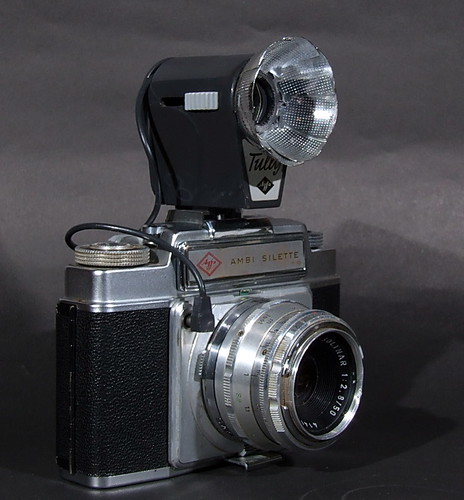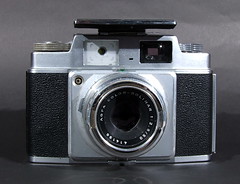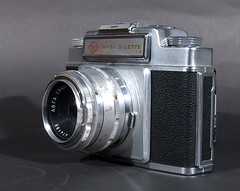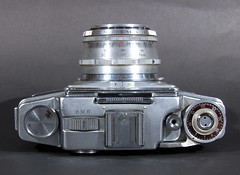Agfa Ambi Silette is a interchangeable lenses 35mm film rangefinder camera manufactured by Agfa Kamerawerk AG, in Munich, West Germany, and produced between 1957-1961. The Ambi Silette was the interchangeable lens member of the Silette range of Agfa cameras which included scale focus viewfinders named Silette and fixed lens rangefinders named Silette Super (Sold in the USA as ANSCO Memar and Super Memar). The Ambi Silette was not rebranded by ANSCO for sale in the USA.
The Ambi-Silette was introduced in Photokina 1956, as a result of Deckel developing a behind the lens leaf shutter. The behind the lens leaf shutter was an advance for the time, but had several well documented disadvantages. Among those having a small maximum diameter (25mm), relatively slow maximum speeds (~1/500) and the inability to support lenses that extend to the rear as they would touch the shutter blades.
The camera went on sale in 1957 in Germany and 1958 in the rest of the world, and while it was expensive for the time it was a fraction of the cost of a Leica. AGFA bet a lot of their future into this camera, even offering a lifetime guarantee. [1] Initially 3 lenses were offered with the camera, 50/2.8, 35/4 and 90/4. AGFA developed these lenses are a whole interchangeable unit, not just the front unit as in the Contaflex lens mount. The lens mount is a clamp/bayonet style mount, with only 1 indexing tab which makes switching lenses very easy. In order to provide the best experience with the interchangeable lenses, AGFA introduced a very innovative viewfinder design with variable bright framelines which are selected manually for the 50, 35 and 90mm lenses, and automatic parallax correction. For today's standards the viewfinder is relatively small, but the framelines and the rangefinder are bright and easy to use.
An updated version (Type II) of Ambi Silette appeared in 1959. The most significant change to the camera was a revised rangefinder with a 5mm wider base, probably to match the 130mm lens that was launched at the time other changes included: [1][2]
- Front look changed, as the RF and frameline windows are separated
- Addition of strap lugs
- 35mm Frame Lines disappear when 90mm Frame Lines are selected
- Change in order of Frame Lines from 35-50-90 to 50-35-90
- Exposure counter changed from additive to subtractive order
- Cosmetic changes to the film advance lever and film reminder dial
Sales of the Ambi Silette were good, but rangefinder sales were quickly surpassed by SLRs in which AGFA never found success, despite its efforts with the Agfaflex line, production of the Ambi Silette ceased in 1961.
Specifications

|
Ambi Silette Type II (1959)
with all 4 interchangeable lenses
and 130mm auxiliary viewfinder
image by eBayer ellawr-50 (Image rights)
|
|
|
|
- Film format: 135 film cartridges (perforated 35mm film) with a 24x36mm image
- Shutter: Synchro-Compur behind the lens leaf shutter. Speeds: B, 1-1/500 ; Setting : ring set close to camera body, with 2 little handles.
- Shutter release: on the right of the top plate, standard cable release socket
- Film winder: Short stroke winder, acts as cocking lever
- Frame counter: coupled with winding lever, advance type, manual setting
- Type I cameras have an additive frame counter, reset mark has a red A
- Type II cameras have a subtractive frame counter, reset setting depends on number of frames of film (red triangles for 20 and 36 exp rolls)
- Lens Mount: bayonet, very easy mounting 43.5mm register distance
- Lens release: press the lens release button on the lower front of the lens mount and simultaneously turn the lens counter clock-wise gripping the fixed milled ring on the lens
- Lenses: interchangeable lenses [3] [4][5]
These lenses were sold in a plastic capsule with silica gel inserts. All lenses use the same size filters 37mm slip-on or 35.5mm screw-on with the exception of the 130mm lens which appeared later (1959)
- 50mm f/2.8 Agfa Color-Solinar (4 elements in 3 groups - 5 blade diaphragm) sold as standard lens and is the well known AGFA version of the Tessar
- 35mm f/4 Color-Ambion (4 elements in 3 groups - 5 blade diaphragm)
- 90mm f/4 Color-Telinear (5 elements in 4 groups - 5 blade diaphragm)
- 130mm f/4 Color-Telinear (6 elements - 5 blade diaphragm) - This lens uses 62mm filters and requires an extra viewfinder for composing.
- Recently a 35mm f/2.8 Schneider Curtagon (Agfa Typ 4401-100) was reported by Michael Wescott Loder[6] and seems to be a prototype.
- View finder: coupled view/rangefinder, matching RF images, w/ bright-line frames, parallax correction by a switch on the top plate adjusts to the 35-50-90mm lenses, the 130mm lens required a separate viewfinder for composition
- Focusing: matching yellow-dot rangefinder images in the finder, coupled with the distances ring on the lens, w/DOF scale; Focus range: 1-10m +inf
- Flip-up cover: protecting the view- and rangefinder windows on front of the camera, and providing shade.
- Self-timer: ~8s, set the small green lever above the shutter to V after winding. Lever resets to X after pressing shutter release
- Flash PC socket: on the front plate, right of the shutter.
- Flash-sync adjustment via the small green lever on the top of the shutter; M 1/60-1/500, X all speeds with electronic flash
- Back cover: Hinged, opens by the latch on the left side of the camera
- Others: Cold-shoe; Memory dial; Tripod socket 1/4 inch; Supporting slide on the front of the bottom plate for tabletop use.
- Dimensions: 125x90x40mm (5.0x3.5x1.6") LxHxD without lens
- Weight: 530g (~18.5 oz) without lens
Notes
Links
